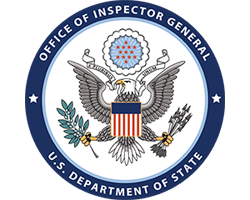11/23/2022
Department of State
Inspection of the Afghanistan Affairs Unit
Inspection / Evaluation
Agency-Wide
View Report
View Report Highlights
Submitting OIG
Department of State OIG
Number of Recommendations
6
Report Number
ISP-I-23-05
11/23/2022
Internal Revenue Service
Controls to Prevent and Recover From Ransomware Attacks Were Generally Effective
Audit
Agency-Wide
View Report
View Report Highlights
Submitting OIG
Treasury Inspector General for Tax Administration
Number of Recommendations
0
Report Number
2023-20-002
11/23/2022
Federal Deposit Insurance Corporation
DOJ Press Release: Hilo Man Receives 42 Months in Prison for Defrauding Covid-19 Relief Programs
Investigation
View Report
View Report Highlights
Submitting OIG
Federal Deposit Insurance Corporation OIG
Report Number
PR-11-23-22
11/22/2022
AmeriCorps
Semiannual Report to Congress: April 1, 2022 - September 30, 2022
Semiannual Report
Agency-Wide
View Report
View Report Highlights
Submitting OIG
AmeriCorps Office of Inspector General
Number of Recommendations
13
Report Number
SAR2022Vol-2
11/22/2022
Department of the Interior
Semiannual Report to Congress for the Period Ending September 30, 2022
Semiannual Report
Agency-Wide
View Report
View Report Highlights
Submitting OIG
Department of the Interior OIG
Report Description
This semiannual report summarizes the work we completed from April 1, 2022, through September 30, 2022, to deter fraud, waste, and abuse.
Number of Recommendations
174
11/22/2022
Federal Maritime Commission
Semiannual Report to Congress: Covering April 1, 2022 - September 30, 2022
Semiannual Report
Agency-Wide
View Report
View Report Highlights
Submitting OIG
Federal Maritime Commission OIG
Number of Recommendations
0
11/22/2022
Chemical Safety and Hazard Investigation Board, Environmental Protection Agency
Semiannual Report to Congress: April 1, 2022–September 30, 2022
Semiannual Report
Agency-Wide
View Report
View Report Highlights
Submitting OIG
Environmental Protection Agency OIG
Report Description
See the additional details link below for the full report, report summary, multimedia or any agency follow-up.
Report Number
350-R-22-002
11/22/2022
Federal Deposit Insurance Corporation
DOJ Press Release: Camden County Resident Sentenced to 41 Months in Prison for Defrauding COVID-19 Relief Programs and Illegally Possessing Firearm
Investigation
View Report
View Report Highlights
Submitting OIG
Federal Deposit Insurance Corporation OIG
Report Number
PR-11-22-22
11/22/2022
Federal Deposit Insurance Corporation
DOJ Press Release: Somerset County Man Admits $850,000 Paycheck Protection Program Fraud Scheme
Investigation
View Report
View Report Highlights
Submitting OIG
Federal Deposit Insurance Corporation OIG
Report Number
PR-11-22-22-2
11/22/2022
U.S. Postal Service
¬¬¬¬¬Efficiency of Selected Processes - Fort Point Station, Boston, MA
Audit
View Report
View Report Highlights
Submitting OIG
U.S. Postal Service OIG
Report Description
This interim report presents the results of our self-initiated audit of the efficiency of selected processes at the Fort Point Station in Boston, MA. The Fort Point Station is in the Massachusetts-Rhode Island District of the Atlantic Area. We judgmentally selected the Fort Point Station for our audit.
Number of Recommendations
0
Report Number
22-188-1-R23
